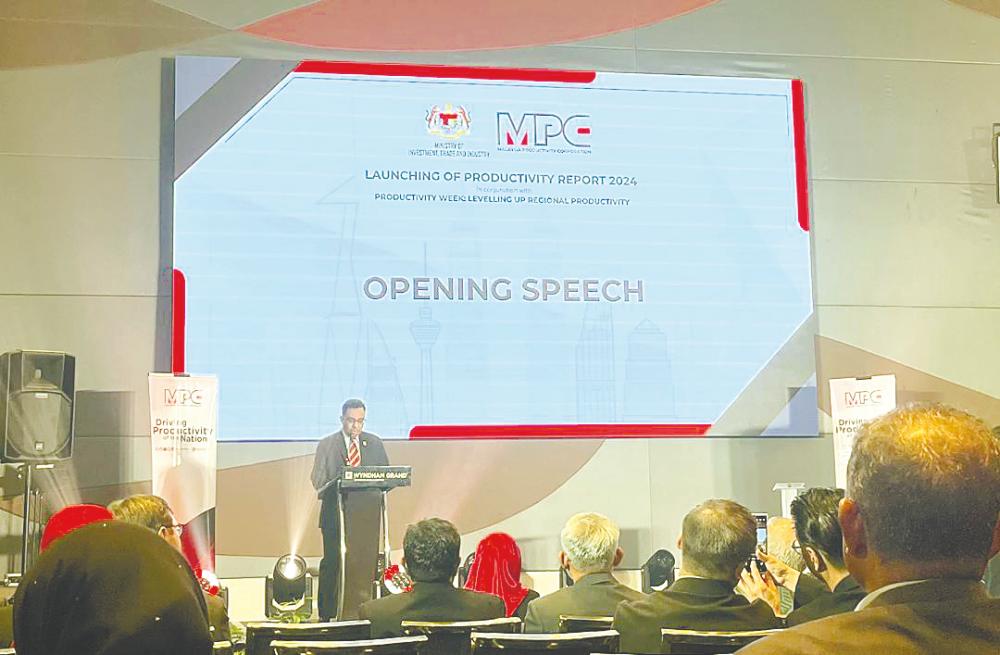KUALA LUMPUR: Malaysia has the potential to enhance its overall productivity by adopting artificial intelligence-related technology, according to Minister of Investment, Trade and Industry (Miti), Tengku Datuk Seri Zafrul Tengku Abdul Aziz.
“AI’s potential to simplify complex and mundane tasks boosts productivity and opens doors to creativity and strategic thinking. A study on generative AI on skilled workers indicated that AI improved performance by around 40%,” he said in his speech at the launch of Productivity Report 2024 today. The speech was read out by Miti secretary-general Datuk Hairil Yahri Yaacob.
Alongside AI is the move to enhance research and development (R&D) to increase economic complexity. This is by producing and delivering competitive products and services, enabling companies and economies to enter higher-value global chains, he added.
“In R&D, process innovation is equally as important as product innovation and critical to boosting productivity,” he said.
Intertwining with technology adoption is the shift towards an industry-driven, he said high-skilled workforce, in which digital skills and competencies are among the talents’ main characteristics.
“The government is committed to creating more high-skill jobs as investments flow into the country.
“With this, we aim for higher salaries and better incentives for the Malaysian workforce,” he said.
Alongside technology and talent, he said the government is responsible for creating a supportive regulatory environment to affect productivity improvement.
He said regulations should facilitate growth, reducing unnecessary compliance costs and resource use for businesses.
“Miti is committed to implementing our Zero Red Tape initiative to prosper our investment and business climate,” he said.
Meanwhile, MPC director-general Zahid Ismail said the Productivity Report 2024 recommended emphasis on regulation, technology, and talent to multiply productivity growth.
“Policymakers and regulators should apply the Good Regulatory Practice (GRP) approach to facilitate business, trade, and investment. Businesses, especially small and medium enterprises (SMEs), should adopt technology and modern management practices to increase efficiency and minimise costs. Policymakers, companies, workers, and academicians must work together on labour market reform to ensure a demand-driven skilled workforce.”
“We are optimistic about achieving the productivity target of an average 3.7% annual growth rate between 2021 and 2025, with a productivity level of RM107,170 per employee in 2025, as outlined in the Mid-Term Review of the Twelfth Plan,” said Zahid.
Malaysia is ranked 34th out of 67 countries in the 2024 World Competitiveness Ranking (WCR), dropping seven places from its 27th ranking last year.
The WCR Report released by the International Institute for Management Development (IMD) ranked Malaysia fourth among Asean countries after Singapore, Thailand, and Indonesia.
Singapore emerged as the most competitive economy in the world, climbing four places from the previous year to surpass Switzerland in second place.
The report said that Malaysia fell behind in almost all assessed areas, including economic performance, government efficiency, and business efficiency.
It maintained its 35th position in 2023 for the infrastructure area.
Malaysia maintained its second-place ranking in the price sub-factor and ranked 11th in tax policy, although both positions decreased by one place from last year.
Malaysia fell 19 places to the 35th spot in the domestic economy sub-factor and 17 places to 53rd in the productivity and efficiency area. It also ranked 50th for business legislation.
IMD said the main challenges for Malaysia are increasing investment in research and development (R&D) to boost business resilience, and optimising the labour market to maximise workforce productivity.
Other challenges include updating policies and regulations to improve global competitiveness, leveraging advanced technologies to accelerate productivity growth and mitigating increasing costs through strategic productivity enhancements.









